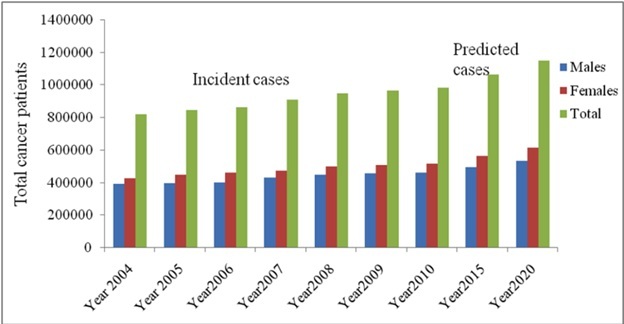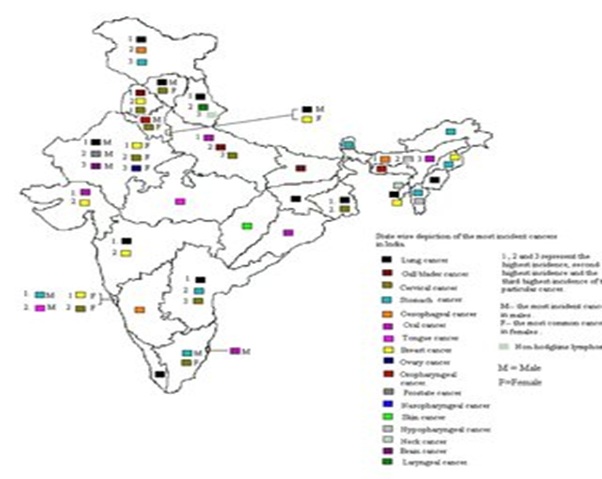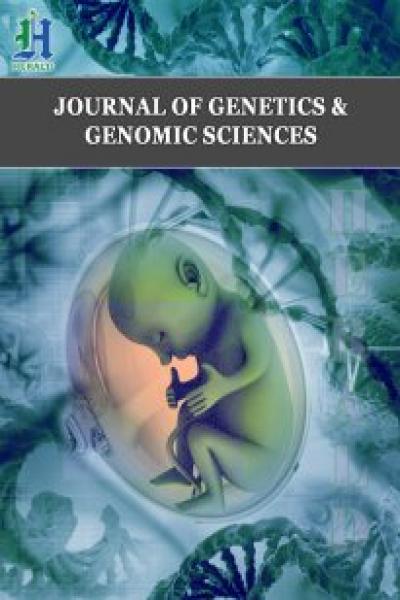
Journal of Genetics & Genomic Sciences Category: Genetics
Type: Research Article
Cancer Scenario in India
*Corresponding Author(s):
Neeraj JainSri Guru Ram Das University Of Health Sciences, Amritsar, India
Tel:+91 9814299045,
Email:neer1967@yahoo.com
Received Date: Aug 10, 2019
Accepted Date: Dec 18, 2019
Published Date: Dec 25, 2019
Abstract
India is a developing country. The present population is 1.35 billion of which 1.4 million Populations are diagnosed with cancer every year. A total of 2.25 million cases are prevalent at a given time, mortality from cancer is as high as 1.2 million. Cervix and Breast are leading cancers among females and head neck and lung are leading cancers among males. Due to poverty and illiteracy there is lack of awareness which leads to presentation at advanced or metastatic stage. The treatment in most of cases is palliative. Though now the awareness about cancer has increased and urban population is very conscious about the disease (Figure 1).

Figure 1: Total Cancer patients.
ETIOLOGY
The chemical, biological and other environmental identities are responsible for uncontrolled and unorganized proliferation of cells (carcinogens). Basically, under special circumstances carcinogens interact with DNA of the normal cells resulting into a series of complex multistep processes responsible for uncontrolled cell proliferation or tumors [1]. The causes for cancers can be both either internal factors like inherited mutations, hormones, and immune conditions or environmental factors such as tobacco, diet, radiation and other infectious agents. In the developed and developing countries, radiations are also notorious carcinogens. The consumption of tobacco is the leading cause of cancers in India. Approximately 87% males and 85% females have been found to have lung cancer due to tobacco smoking in the form of bidi (a thin South Asian cigarette type structure filled with tobacco flake and wrapped in a tendu leaf, tied with a string at one end) and cigarette in India [2,3]. About 10% cancer occurrence is due to radiation effect, both ionizing and non-ionizing [4]. A significant variation of cancer has been reported due to life styles and food habits [5]. For example, Asians have 25 and 10 times lower incidences of prostate and breast cancers, respectively, as compared to Western countries which may be attributed to comparatively simple life styles adopted by Asians, and safe sexual practices. It is interesting to mention here that the rates of these cancer incidences increase substantially when Asians migrate to the Western countries; indicating a clear relationship of carcinogenesis with food habits and living styles. The various cancer causes have been compiled by visiting various hospitals, cancer agencies and institutes and plotted in figure 2. Some important causes of cancer in India are discussed in the following sub-sections briefly.

Figure 2: Demographic Variations.
DEMOGRAPHIC VARIATIONS
There is lot of financial, religious and demographic variations in the country. In 1960 more than 80% population were rural but now 60%. Urbanization has lead to increased incidence of cancer. In North East region of the country cancer incidence is very high this is due to Tobacco and household burning of firewood. Incidence of Stomach cancer is high in South India due to diet rich in salt and spices. In Malwa region of Punjab incidence of Cancer Oesophagus, Gall Bladder, and Breast is high dueto high use of pesticides and diet rich in fats. In states of UP, Bihar, MP incidence of oral cancer is very high due to habit of tobacco chewing.
DIAGNOSTIC FACILITIES
- FNAC/ BIOPSY available at Urban Centers
- IHC available in Metro cities
- Radiologyavailable inSemi urban and urban areas
- PET CT available in Urban Centers only
TREATMENT FACILITIES
Treatment facilities are lacking due to overpopulation, there are only 3500 qualified Radiation Oncologists in 300 centres and there is shortage of 600 centers as per WHO criteria. There are 400 teletherapy machines out of which 50% are Cobalt units and shortage of 1200 units. Doctor Patient ratio is 1:2000 needs to be reduced to 1:1000. Medical oncologists are less than 2000 and confined to higher and corporate centres in Metro cities and beyond the reach of majority of population. Same scenario is of surgical oncologists and most of cancer surgeries are unplanned and done at peripheral centres by general surgeons. Radiation and Surgical oncologists also practice chemotherapy.
FINANCIAL CONSTRAINTS
Financial constraints are other issue for a radical and effective treatment, only 5% population can afford treatment of their own and 50-60% can afford treatment with difficulty or with the help of insurances. Lack of health insurance leads to a financial burden on effected family and despite being in a curable stage the patient fails to get required treatment. Central and state governments have started funding programs for diagnosis and treatment but still therapies are beyond reach of majority people. More funds are being allocated under National Cancer Control Program with sole aim of early detection and cure. A 700 bedded National Cancer Institute has been established near New Delhi for research and treatment of cancer.Pharma companies are also running Patient Assistance Programs and costly medicines are given as free cycles after patient purchases initial cycles.
REFERENCES
- Carmaeia B (1993) Molecular mechanisms in cancer induction and Prevention. Environ Health Perspect 101: 237-245.
- Behera D, Balamugesh T (2004) Lung Cancer in India. Indian J Chest Dis Allied Sci 46: 269-281.
- Notani P, Sanghavi LD (1974) A retrospective study of lung cancer in Bombay. Br J Cancer 29: 477-482.
- Belpomme D, Irigaray P, Hardell L, Clapp R, Montagnier L, et al. (2007) The multitude and diversity of environmental carcinogens. Environ Res 105: 414-429.
- Helbock HJ, Beckman KB, Shigenaga MK, Walter PB, Woodall AA, et al. (1998) DNA oxidation matters: the HPLC-electrochemical detection assay of 8-oxo-deoxyguanosine and 8-oxo-guanine. Proc Nat Acad Sci USA 95: 288-293.
Citation: Jain N, Jain S, Rakesh A (2019) Cancer Scenario in India. J Genet Genomic Sci 4: 014.
Copyright: © 2019 Neeraj Jain, et al. This is an open-access article distributed under the terms of the Creative Commons Attribution License, which permits unrestricted use, distribution, and reproduction in any medium, provided the original author and source are credited.
© 2025, Copyrights Herald Scholarly Open Access. All Rights Reserved!

